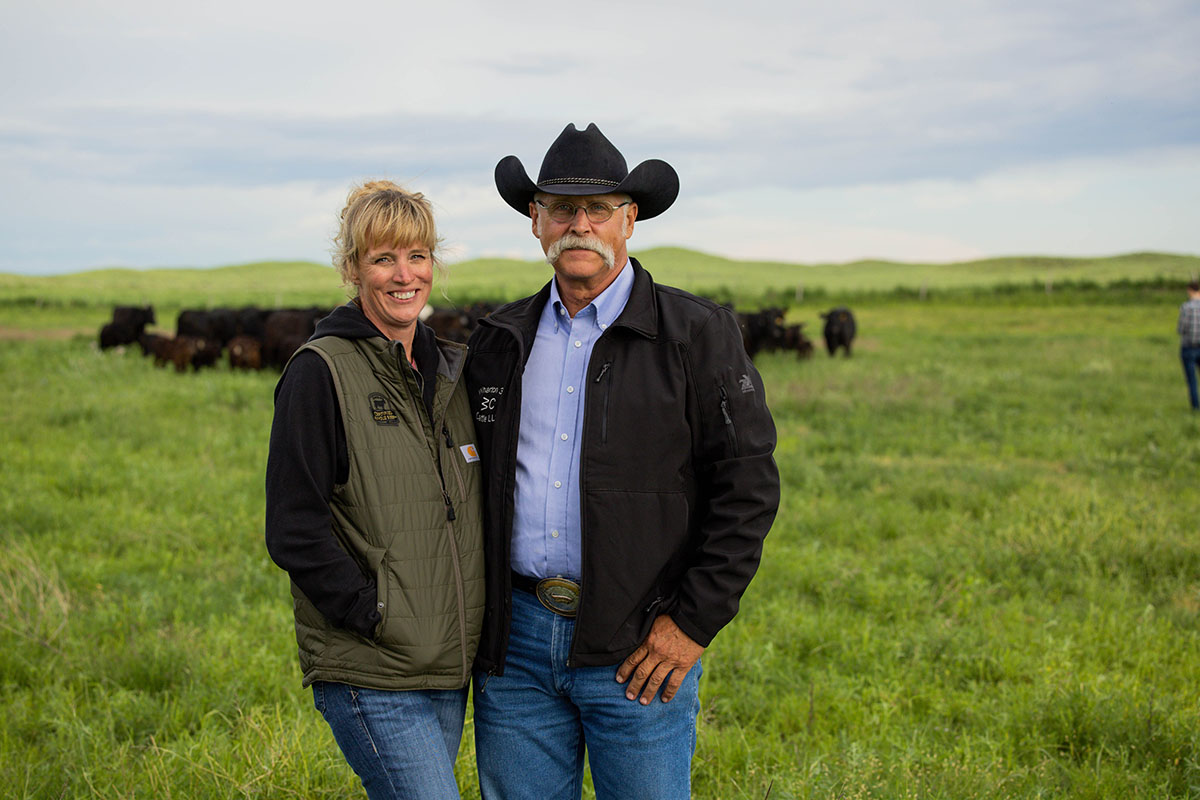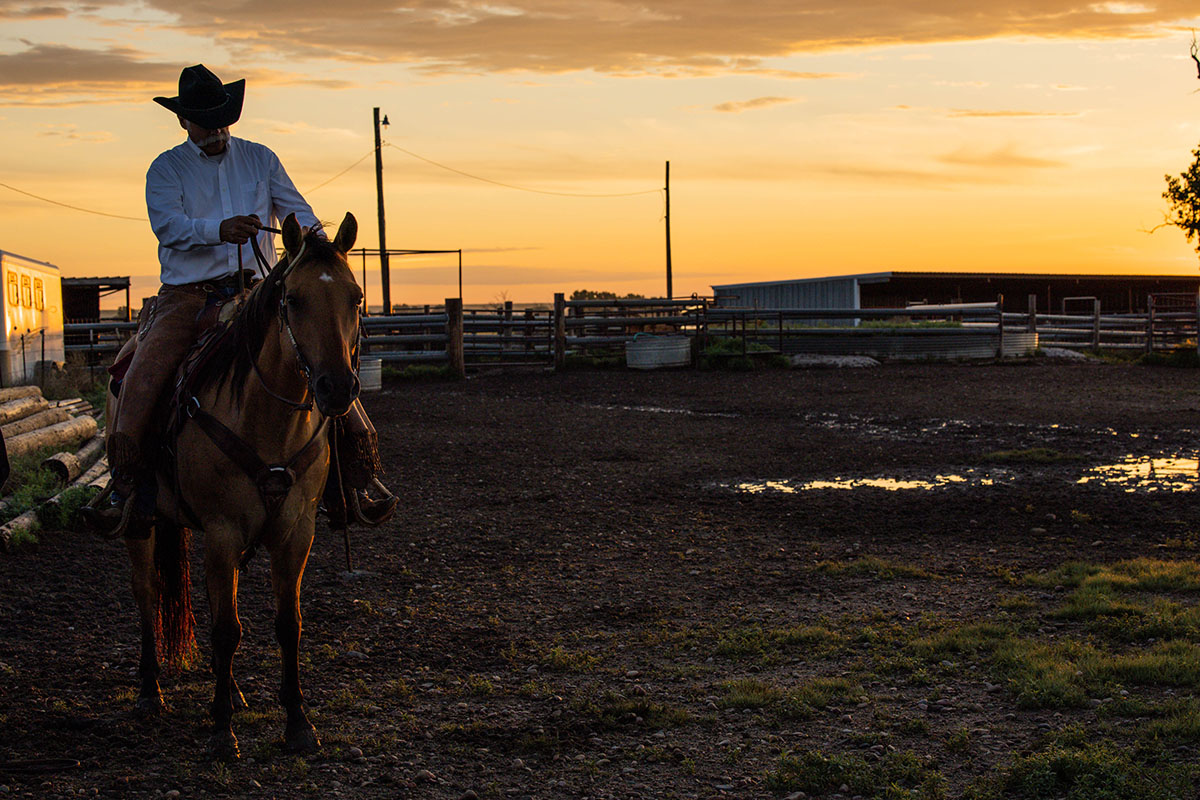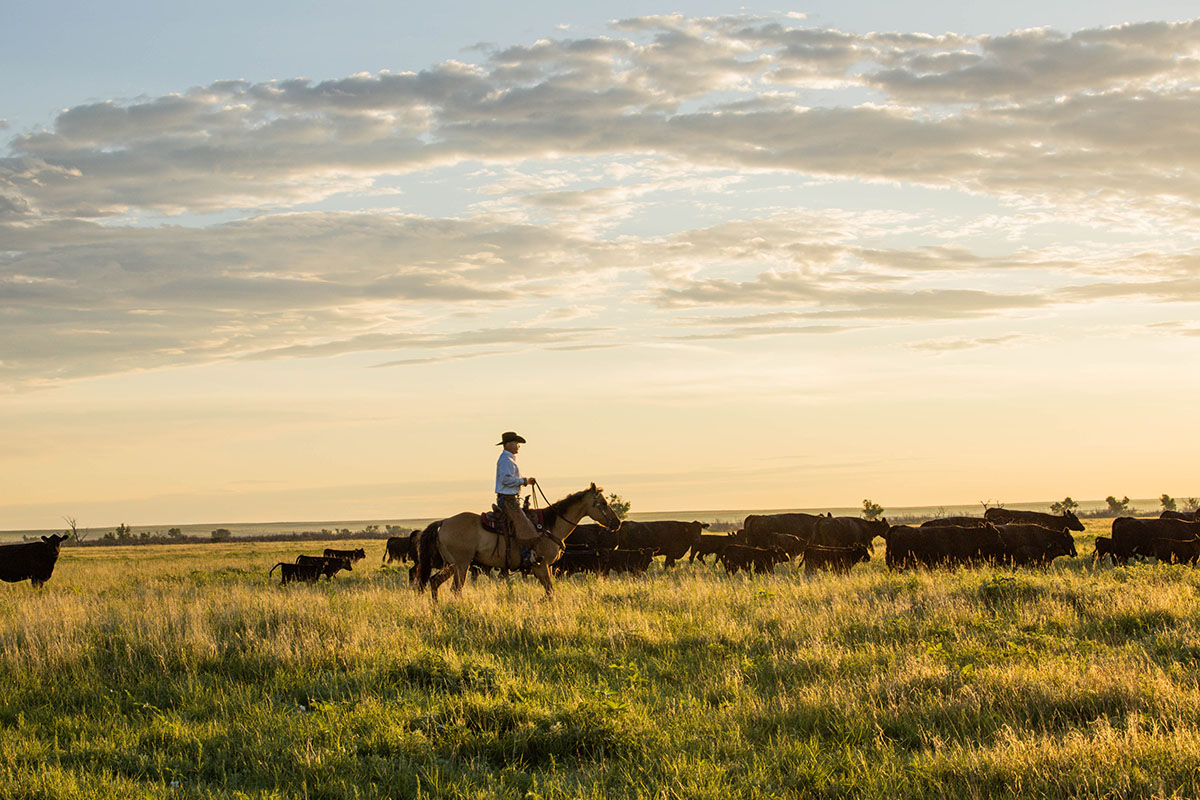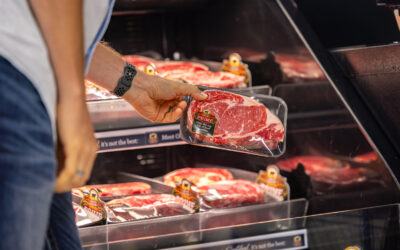
Making It Better
One family’s journey from town to the peak of premium beef production earns the CAB Sustainability Award for Wharton 3C Cattle.
Story and photos by Nicole Lane Erceg
October 2023
Most sane folks don’t choose to go into business with Mother Nature. She’s a fickle and unpredictable partner.
So, how did two people with zero agricultural background, no generational land, wealth or genetics carve a profitable partnership with her in Southwest Kansas?
“Shannon is the brains and I’m the brawn,” Rusty Wharton jokes.
The real answer is a little more nuanced.
An Oasis on the Plains
The view of Wharton 3C Ranch, near Syracuse, Kansas, in the summer of 2023 is so green Shannon and Rusty Wharton might have better luck convincing people it is a slice of heaven rather than the harsh, drought-ridden environment locals know.
Don’t expect to make a visit to the ranch without a 4-wheel drive vehicle. The cattle will tell you; it isn’t always this pleasant. In fact, a few years ago, there wasn’t a cow in these pastures, lack of rain left the soil unable to produce much more than dust.
The commercial outfit is made up of about 600 head spread across more than 35,000 acres, most of that a Western Association of Fish and Wildlife conservation easement. A 1,000-head grow yard prepares calves for finishing. The Whartons have been managing it for various owners since 2005.
“We either had enough money to buy the land or to buy the cattle, never both,” Rusty says.
The last time it changed hands in 2017, they made the numbers work, purchasing the cattle and a little land, leasing the rest.
A mix of puzzle pieces built over time made the unlikely a reality for this military service veteran and a horse girl from Pennsylvania who carve out their own place in the cattle business.
Becoming Experts
The Wharton family story started in Kentucky where the couple met and married. Rusty fell into commercial ranching via a rodeo friend; Shannon found her passion for cattle through Block and Bridle at Penn State. After her master’s degree in cattle breeding and genetics from the University of Kentucky, she wanted to go to west to Montana. Texas was calling Rusty’s name.
They split the difference when the only job opportunity that made sense was a position for Shannon at Grant County Feeders in Ulysses, Kansas.
“My dad thought I was crazy,” she says. “He asked what in the world I was doing with that master’s degree. I was driving a feed truck and chasing dreams.”
The decision to learn the feeding business was strategic. Already familiar with the commercial ranching, they decided making it in the cattle business would mean learning all the sectors.
Their family mission statement then is a bit fuzzy now, but it boiled down to working together to make the cattle industry better.
Humble, willing to work hard, listen and learn, the path to their own operation took them across the Midwest managing ranches and working in feed yards. Their teachers read like a cattle industry hall of fame, including Mark Gardiner, Sam Hands, Minnie Lou Bradley and Larry Corah, among others.
“There were a lot of opportunities that opened up for us because of our willingness to work hard, but also because of our open, business-focused, progressive way of thinking,” Shannon says.
Decades of learning, growing, raising all types of cattle in diverse environments under different philosophies provided a list of lessons that would direct what to do (and not to do) if they ever had full control of the reins.
“What we thought were setbacks at the time were actually learning opportunities that made us better,” Shannon says.
At Wharton 3C Cattle, if you want to know the details of the land, grass, wildlife and irrigation Rusty has forgotten more than most will ever know. When it comes to genetics and data-based decision-making and running the balance sheet, Shannon is the expert. Equal partners with a shared passion for the cattle.
“We each have our areas of expertise, and they don’t overlap except for the cows,” Shannon explains.
“If she passed tomorrow, I’d be so out of luck,” Rusty admits. “I don’t even know how to open Quickbooks.”
Shannon rolls her eyes with a smile, sharing she’d also be up a creek without a paddle if he weren’t by her side.


A Better Way
Unburdened by tradition that sometimes saddles generational ranches, the Wharton’s mindset is business first. Follow the science and data in selection and management, then work to get better every day.
“We have our goal towards quality, not only quality in the meat we produce, but also quality of the land,” Shannon says. “What’s the point of doing it if you’re not striving to be the best you can be?”
Involved in retained ownership since the 1990s, the couple tracks everything from conception to carcass data. A recent load of cattle were 100 percent Certified Angus Beef ®, including 92 percent Prime. They achieved 87 percent or higher CAB and Prime across all their 2021 fed cattle. Premiums on those cattle add some extra black ink to the bottom line.
But it’s about more than data and dollars.
People and an industry-wide vision drive them to build not only their section of the cattle business, but the entire industry.
“We all need each other,” Shannon explains. “Without the cow-calf producer restaurants don’t have great beef to serve, without the packer, our product doesn’t get to those restaurants and consumers don’t have access to it. And commercial producers need someone to feed and finish those cattle. So, it’s very important that we all work together and realize in the end, we’re all producing the same product.”
This thought process for greater industry engagement led Shannon to get involved in the U.S. Roundtable for Sustainable Beef (USRSB).
“It’s such a neat organization where we can have the whole supply chain sit down together and say, okay, from the producer all the way to the retailer, we’re producing this beef. Let’s do it to the best of our ability. Let’s make sure we’re not impacting the environment negatively. Let’s ensure we’re taking care of the animals and our employees.”
The USRSB framework aligns with the Whartons’ mindset on management.
“We have to be sustainable to be in this business.” Rusty says. “If we don’t do the right thing with the grazing management plan, if we don’t take care of the cattle properly and if we fail to bring together our customer base, then we’re not going to be in business.”
Rusty admits he’s been one to store cattle or grazing data in his head or scribbles in a dashboard notebook. However, technology to sort and the discipline to keep records allow him to run their cattle operation like any other business. That recorded and analyzed data enables good decisions, workable drought plans and meeting the requirements of take 1/3, leave 2/3 when grazing the conservation easement.
“It helps you stay focused when you need to make a move,” Rusty says.
The most valuable takeaway for the couple’s USRSB involvement has been opening new avenues of communication. Shannon has firsthand experience in how simple management tools like Beef Quality Assurance certification and written grazing management plans can align values across the beef supply chain.
“Being involved in the U.S. Roundtable for Sustainable Beef has impacted how we communicate what we do, because we’ve been doing this for a long time and this is what we believe in,” Shannon says. “So, our communication about sustainability is improved by the Roundtable.”

“We have to be sustainable to be in this business.” Rusty says. “If we don’t do the right thing with the grazing management plan, if we don’t take care of the cattle properly and if we fail to bring together our customer base, then we’re not going to be in business.”

Building for the Future
Rusty and Shannon’s children, the three C’s of Wharton 3C Cattle; Catie, Clayton and Cara have taken the lessons learned growing up on ranches, crawling around feedyard offices and riding in feed trucks into their own careers. All went to college to study agriculture. Catie works for Plains Cotton Growers in Lubbock, Texas. Cara is finishing her degree in agriculture economics with plans to farm with her fiancé in Nebraska and Clayton just moved home to Syracuse to join the family business and teach high school agriculture at the local school.
“You maybe aren’t going to be a millionaire working in agriculture, but money’s not everything,” Shannon says. “And if you go to work every day and you’re passionate about what you do and you love what you do, then it’s not work. Then it’s just fun.”
It also takes grit. The balance of pure joy from the hard work of doing something they love and riding out the rough storms along the way turned two first-generation cattle ranchers into legacy builders.
Honored with the Certified Angus Beef Sustainability Award in September at the brand’s annual conference in Las Vegas, Nevada, the Whartons embody progress and ways to leave things better than they found them.
“I hope the legacy of our ranch is quality,” Rusty says.
Originally published in the Angus Journal.
You may also like
CAB Sets Sales Records, Sees Historically High Brand Acceptance Rates
In an otherwise tough time in the beef business, sales and supply records have been a bright spot. The positive numbers mean that quality beef production has not let up, and beef demand is holding. Consumers have proven the value proposition: the good stuff is worth a little more money, for a better eating experience.
Feeding Quality Forum Dates Set Earlier in August
When you’re feeding cattle, it counts to keep track of every calf, pound and dollar. Beyond the event’s educational sessions, networking between segments of the beef supply chain is invaluable—from feeders and cow-calf operators to allied industry and university researchers.
Gardiners Highlight Service, Strength at Foodservice Leaders Summit
Mark Gardiner and his son, Cole, of Gardiner Angus Ranch offered a boots-on-the-ground perspective for CAB specialists attending the annual event, designed to deliver resources that help train foodservice teams and serve consumers at a higher level.



